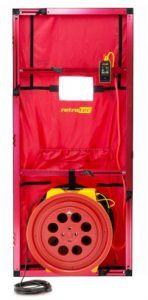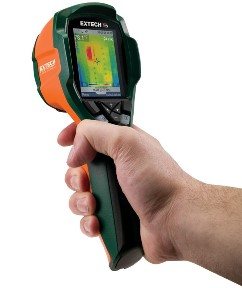
The test involves one of the evaluator’s most important pieces of equipment, the blower door. At Eco Three, we use Retrotec blower doors. The blower door is essentially a calibrated fan that either depressurizes or pressurizes the home. This fan fits inside a framed nylon shroud that is set up inside an open exterior doorway, and a small computer called a manometer measures pressure differential between the inside and outside and controls fan speed. In most cases, the b
During the test, an evaluator will use tools (such as a thermal camera or a smoke pen) or the feeling of touch to identify air leaks throughout the home. We usually use a thermal imaging camera from FLIR that is especially helpful in identifying air leaks, specifically where hot or cold outside air is being pulled into the conditioned space of the home from outside, the attic, or basement/crawlspace.
The evaluator can then compare the manometer’s reading to the home’s building airflow standard (BAS), which is a calculated range of optimal airflow for that particular home/building. The BAS is unique for every built structure, and it is based on square footage, volume, number of stories, climate region, and what are referred to as “N factors.” If the measured amount of airflow in the home is greater than the BAS range, then the home/building is considered to be leaky, and improvements can be made to seal the building envelope tighter. A properly air sealed home/building reduces or eliminates drafts from outside while ensuring the air you pay to heat or cool stays inside the conditioned areas.
Contact us today to perform a blower door test on your home or building.